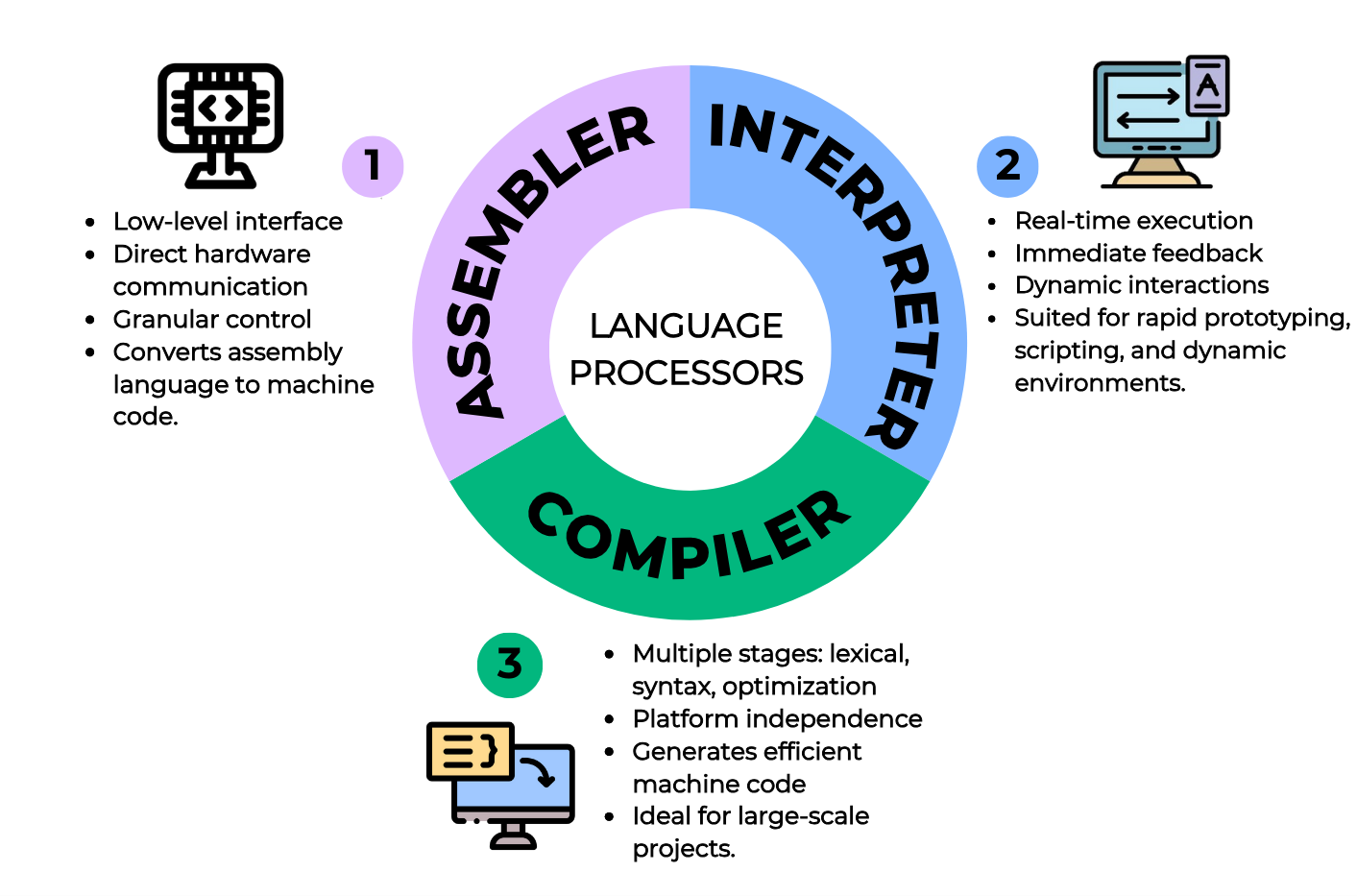In programming languages, language processors play a vital role in converting code that is readable to humans into instructions that machines can execute. These processors, including Compiler Interpreter and Assembler, form the backbone of software development.
What Are Language Processors?
Language processors are software tools that handle the translation and execution of programming languages. They play a crucial role in converting human-readable code written in high-level programming languages into machine-readable instructions that a computer can execute. These processors are essential components in the software development lifecycle.
Types of Language Processors:
There are largely 3 major language processors, namely, compiler interpreter and assembler.
- Assembler: Translates assembly language code into machine code. It provides a low-level interface, enabling direct communication with the computer’s hardware.
- Compiler: Translates high-level programming code into machine code before execution. It includes multiple stages like lexical analysis, syntax analysis, optimization, and code generation.
- Interpreter: Executes high-level code line by line in real-time without prior compilation. It provides immediate feedback during development and allows for dynamic interactions with the program.
Where and Why Are They Used?
- Software Development: Language processors are fundamental in software development, allowing developers to write code in high-level languages for readability and then translating it into machine code for execution.
- System Programming: Assemblers are often used in system-level programming and firmware development where low-level control over hardware resources is crucial.
- Application Development: Compilers are widely used in application development, providing optimized and platform-independent code. Popular languages like Java and C++ rely on compilers.
- Scripting and Rapid Prototyping: Interpreters are favored in scripting languages like Python and JavaScript for their adaptability and quick development cycles. They are valuable for rapid prototyping and dynamic scripting.
.png)
II. Assembler:
An assembler is a low-level language processor designed to translate assembly language code into machine code, which consists of binary instructions directly understandable by the computer’s central processing unit (CPU). In essence, it serves as a bridge between human-readable assembly language and the hardware-level machine code.
The primary function of an assembler is to convert mnemonic representations and symbolic addresses in assembly language into their binary equivalents. This process, known as assembly, involves parsing the assembly code, generating machine code, and facilitating the creation of executable programs.
But why is assembler used when we have high-level languages?
- Fine-grained control: Assemblers offer unmatched granularity. You can directly manipulate hardware registers and memory, giving you control over performance and optimization. This is crucial for resource-constrained environments like embedded systems or high-performance computing.
- Efficiency: When every cycle counts, assembly works best. The generated code is typically smaller and faster than its compiled counterparts, making it ideal for such situations.
- Hardware-specific: Each processor architecture has its own instruction set. Assemblers provide a way to tap into the unique capabilities of a specific chip, something compilers might struggle with.
However, assemblers come with their own baggage:
- Complexity: Assembly code is intricate and error-prone. A single misplaced comma can make programs fail. It requires a deep understanding of the underlying hardware and architecture.
- Portability: Assembly code is tightly coupled to the target architecture. Moving it to a different processor, requires rewriting from scratch. Unlike high-level languages, it lacks portability.
III. Compiler:
A compiler is a sophisticated language processor that translates high-level programming code written in languages like C, C++, or Java into machine-readable instructions, typically in the form of binary code or assembly language. A compiler is a type of language processor that translates an entire program written in a high-level language into machine language all at once.
Key Functions of a Compiler:
- Lexical Analysis: The compiler breaks down the source code into lexical tokens, identifying keywords, variables, and symbols.
- Syntax Analysis: It verifies the grammatical structure of the code, ensuring it adheres to the rules of the programming language.
- Semantic Analysis: The compiler checks for semantic correctness, ensuring variables and functions are used in a meaningful way.
- Optimization: The compiler optimizes the code to enhance its performance, applying various techniques like constant folding, loop unrolling, and inlining.
- Code Generation: Finally, the compiler generates the machine code or assembly language code that can be executed by the computer’s hardware.
Usage and Significance:
- Performance Optimization: Compilers play a crucial role in optimizing code for execution, translating high-level abstractions into efficient machine code. This is particularly vital in performance-critical applications and system-level programming.
- Portability: The compiled code is often platform-independent, allowing it to run on different hardware architectures without modification. This contributes to the portability of software across various systems.
- Large-scale Software Development: In large-scale software projects, where codebases can be extensive and complex, compilers streamline the development process by catching errors early in the compilation stage and providing efficient executable code.
- Execution Speed: Compiled code tends to execute faster than interpreted code as the compilation process optimizes the code for the specific target architecture.
IV. Interpreter:
An interpreter is a language processor that directly executes source code written in high-level programming languages without prior compilation. It analyzes the code line by line in real-time and translates each line into machine code or an intermediate form, facilitating immediate execution. Unlike compilers, interpreters skip the separate compilation step, offering dynamic adaptability during runtime.
Interpreters are commonly used in scripting languages like Python, JavaScript, and Ruby, where rapid development and ease of debugging are paramount.
Using internal data structures and algorithms, it converts these high-level constructs into a format that the underlying machine can understand, which is often referred to as bytecode. This bytecode, which is a more machine-friendly representation, is then processed by the virtual machine, a software layer that simulates the capabilities of the actual hardware.
But why would we employ interpreters when compilers reign supreme in performance-critical applications? Here’s where the magic lies:
- Rapid Feedback and Development: Interpreters provide instant gratification. Write a line of code, see the result immediately. This iterative nature fosters rapid prototyping and debugging, invaluable for dynamic languages and exploratory coding.
- Platform Independence: Forget the shackles of specific machine architectures. Interpreters, often written in portable languages, can run your code on various platforms without modification. This cross-platform compatibility makes them ideal for web development and scripting environments.
- Dynamic Environments: Some programming paradigms thrive on adaptability. Interpreters excel in situations where code can modify itself at runtime, like in scripting languages used for system administration or automation.
However, interpreters aren’t without their trade-offs. The line-by-line execution approach inherently incurs a performance penalty compared to compiled code. Additionally, debugging can be trickier as the interpreter works with bytecode rather than the original source code.
V. Difference Between Compiler Interpreter and Assembler
Difference between compiler interpreter and assembler be understood with the following side-by-side comparison:
A. Side-by-Side Comparison
| Criteria | Assembler | Compiler | Interpreter |
|---|---|---|---|
| Functionality | Translates assembly language to machine code | Translates high-level language to machine code | Executes source code directly in real-time |
| Execution | Directly executed by the hardware | Requires compilation before execution | Executes code line by line in real-time |
| Output | Machine-specific binary code | Platform-independent executable code | No separate output, immediate execution |
| Learning Curve | Steep due to low-level operations | Moderate, understanding high-level language constructs | Generally lower due to direct execution |
| Debugging | Challenging, often requires low-level expertise | Possible during source code debugging | Real-time debugging, providing immediate feedback |
| Portability | Highly dependent on the underlying architecture | Portable across different platforms, given compiled code | Code needs the interpreter present, limiting portability |
| Development Speed | Slower due to manual optimization | Moderate, depending on compilation time | Faster due to immediate code execution |
| Resource Usage | Efficient use of hardware resources | Optimized resource usage during compilation | Immediate resource usage without optimization |
B. Performance Considerations
- Speed: Assembler exhibits high speed due to direct hardware execution. Compilers offer a balance, with optimized machine code. Interpreters may have lower speed due to real-time execution.
- Memory Usage: Assembler provides efficient memory usage as it allows direct control. Compilers optimize memory usage but may generate larger executables. Interpreters may have lower memory efficiency due to real-time interpretation.
- Efficiency: Assembler allows for highly efficient code tailored to the hardware. Compilers optimize code during compilation. Interpreters provide adaptability but may sacrifice efficiency for real-time execution.
C. Use Cases for Each Among Compiler Interpreter and Assembler
- Assembler: Critical for system-level programming, firmware development, and scenarios demanding precise control over hardware resources.
- Compiler: Ideal for large-scale software projects, where performance, portability, and optimization are crucial.
- Interpreter: Well-suited for rapid prototyping, dynamic scripting, and situations prioritizing adaptability over raw performance.
In conclusion, the choice among Assembler, Compiler, or Interpreter depends on project requirements, emphasizing the trade-offs between performance, efficiency, and development speed.
Difference between compiler interpreter and assembler makes choosing one them a difficult task, depending on various factors, and the decision should align with the specific requirements and constraints of your project. Here’s a guide to help you make an informed choice:
- Nature of the Project:
- Use an assembler when dealing with low-level programming, system-level tasks, or firmware development that requires precise control over hardware resources.
- Opt for a compiler for large-scale software projects where performance, optimization, and portability are critical.
- Choose an interpreter for scenarios that prioritize rapid prototyping, dynamic scripting, or quick development cycles.
- Performance Considerations:
- If performance is paramount, especially in resource-intensive applications, consider using an assembler or a compiler. They allow for code optimization and generate machine code that directly interacts with the hardware.
- For scenarios where rapid development is more critical than raw performance, an interpreter may be suitable, despite potential trade-offs in execution speed.
- Debugging and Development Speed:
- Interpreters excel in providing immediate feedback during development, making them effective for debugging and rapid prototyping.
- Compilers offer more extensive debugging capabilities than assemblers due to their higher-level abstraction. However, the compilation step can increase development time.
- Assemblers may have a more challenging debugging process due to the low-level nature of the code.
- Portability:
- Compilers contribute to portability by generating platform-independent executables, allowing the same codebase to run on different systems.
- Interpreters can be portable as long as the interpreter itself is available on the target system.
- Assemblers may produce machine-specific code, potentially limiting portability.
- Resource Usage:
- Assemblers provide efficient control over hardware resources but require expertise to optimize efficiently.
- Compilers optimize resource usage during the compilation process, generating efficient machine code.
- Interpreters may have immediate resource usage but may lack the optimization achieved by compilers.
- Project Goals and Constraints:
- Understand the specific goals, constraints, and priorities of your project. Consider the trade-offs between development speed, performance, and resource usage.
IX. Conclusion
In the intricate realm of programming, navigating the nuances among compiler, interpreter, and assembler is pivotal. Assemblers, compilers, and interpreters serve as indispensable language processors, each with distinct strengths and applications. Assemblers offer unparalleled low-level control, compilers optimize for performance, and interpreters provide dynamic adaptability.
Choosing among them hinges on project specifics, balancing factors like speed, resource usage, and development speed. In the dynamic landscape of software development, understanding the differences among compiler interpreter and assembler equips developers to make informed decisions, ensuring code efficiency and project success.


